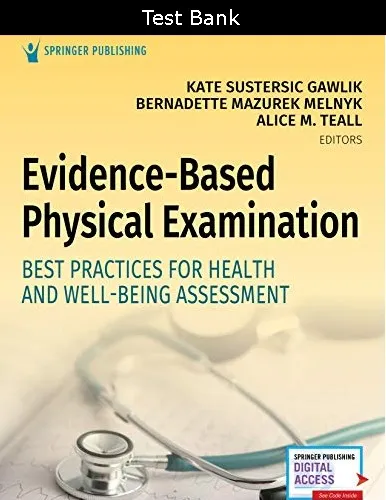Evidence-Based Physical Examination Best Practices for Health & Well-Being Assessment 1st Edition Test Bank
$55.00 Original price was: $55.00.$23.50Current price is: $23.50.
Digital item No Waiting Time Instant Download
Chapters: 29
Format: PDF
ISBN-13: 978-0826164537
ISBN-10: 0826164536
Publisher: Springer Publishing Company
Authors: Kate Gawlik, Bernadette Melnyk, Alice Teall
Description
Evidence-Based Physical Examination Best Practices for Health & Well-Being Assessment 1st Edition Test Bank
Table of Contents
Evidence-Based Physical Examination Best Practices for Health & Well-Being Assessment 1st Edition Test Bank
MULTIPLE CHOICE
1. After completing an initial assessment of a patient, the nurse has charted that his respirations
are eupneic and his pulse is 58 beats per minute. These types of data would be:
a
.
Objective.
b
.
Reflective.
c
.
Subjective.
d
.
Introspective.
ANS: A
Objective data are what the health professional observes by inspecting, percussing, palpating,
and auscultating during the physical examination. Subjective data is what the person says about
him or herself during history taking. The terms reflective and introspective are not used to
describe data.
DIF: Cognitive Level: Understanding (Comprehension) REF: z. 2
MSC: Client Needs: Safe and Effective Care Environment: Management of Care
2. A patient tells the nurse that he is very nervous, is nauseated, and feels hot. These types of
data would be:
a
.
Objective.
b
.
Reflective.
c
.
Subjective.
d
.
Introspective.
ANS: C
Subjective data are what the person says about him or herself during history taking. Objectivedata are what the health professional observes by inspecting, percussing, palpating, and
auscultating during the physical examination. The terms reflective and introspective are not used
to describe data.
DIF: Cognitive Level: Understanding (Comprehension) REF: z. 2
MSC: Client Needs: Safe and Effective Care Environment: Management of Care
3. The patients record, laboratory studies, objective data, and subjective data combine to form
the:
a
.
Data base.
b
.
Admitting data.
c
.
Financial statement.
d
.
Discharge summary.
ANS: A
Together with the patients record and laboratory studies, the objective and subjective data form
the data base. The other items are not part of the patients record, laboratory studies, or data.
DIF: Cognitive Level: Remembering (Knowledge) REF: z. 2
MSC: Client Needs: Safe and Effective Care Environment: Management of Care
4. When listening to a patients breath sounds, the nurse is unsure of a sound that is heard. The
nurses next action should be to:
a
.
Immediately notify the patients physician.
b
.
Document the sound exactly as it was heard.
c
.
Validate the data by asking a coworker to listen to the breath sounds.
d
.
Assess again in 20 minutes to note whether the sound is still present.
ANS: C
When unsure of a sound heard while listening to a patients breath sounds, the nurse validates the
data to ensure accuracy. If the nurse has less experience in an area, then he or she asks an expert
to listen.
DIF: Cognitive Level: Analyzing (Analysis) REF: z. 2
MSC: Client Needs: Safe and Effective Care Environment: Management of Care
5. The nurse is conducting a class for new graduate nurses. During the teaching session, the
nurse should keep in mind that novice nurses, without a background of skills and experience
from which to draw, are more likely to make their decisions using:
a
.
Intuition.
b
.
A set of rules.
c
.
Articles in journals.
d
.
Advice from supervisors.
ANS: B
Novice nurses operate from a set of defined, structured rules. The expert practitioner uses
intuitive links.
DIF: Cognitive Level: Understanding (Comprehension) REF: z. 3
MSC: Client Needs: General
6. Expert nurses learn to attend to a pattern of assessment data and act without consciously
labeling it. These responses are referred to as:
a
.
Intuition.
b
.
The nursing process.
c
.
Clinical knowledge.
d
.
Diagnostic reasoning.
ANS: A
Intuition is characterized by pattern recognitionexpert nurses learn to attend to a pattern of
assessment data and act without consciously labeling it. The other options are not correct.
DIF: Cognitive Level: Understanding (Comprehension) REF: z. 4
MSC: Client Needs: General
7. The nurse is reviewing information about evidence-based practice (EBP). Which statement
best reflects EBP?





Be the first to review “Evidence-Based Physical Examination Best Practices for Health & Well-Being Assessment 1st Edition Test Bank”